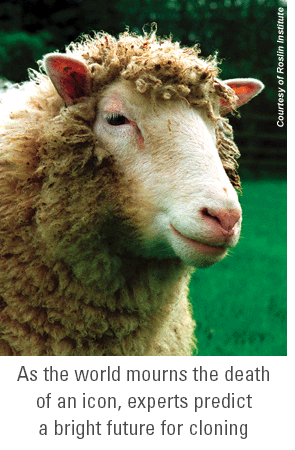Goodbye, Dolly; first cloned sheep dies at six years old
 On Feb. 23, 1997, a group of scientists in Scotland made an announcement that would forever change the way scientists view mammalian development—they had successfully cloned Dolly, a Finn Dorset sheep, from an adult cell. Six years later, Dolly is dead and cloned animals are on the verge of revolutionizing food production and modern medicine. On Feb. 14, 2003, Dolly was euthanatized after veterinarians confirmed she had a progressive lung disease. A necropsy confirmed Dolly had sheep pulmonary adenomatosis, a fairly common disease of sheep, according to a statement from the Roslin Institute in Edinburgh, Scotland, where Dolly was cloned and lived. "Sheep can live to 11 to 12 years of age," said Dr. Harry D. Griffin, the acting director of the Roslin Institute, in a statement. "And lung infections are very common in older sheep, particularly those housed inside (such as Dolly)." The necropsy also confirmed arthritis in her hind limbs—first reported by the Roslin Institute in 2002—however, there is no evidence cloning led to her ailments. Before developing arthritis, Dolly produced six healthy lambs through natural mating. Veterinarians in the field of cloning say it is remarkable that Dolly lived as long as she did given the number of visitors she had and the extra attention she received. Dr. Jose Cibelli, a professor of animal biotechnology at Michigan State University who helped produce the first genetically altered cows through cloning, said it will be difficult to discern whether any abnormalities Dolly had were the result of cloning since the cloning process is not fully understood. "We're not sure what we're looking for," Dr. Cibelli said. Dr. Mark E. Westhusin, an associate professor in the College of Veterinary Medicine at Texas A&M University, who helped clone Carbon Copy—the first domesticated cat clone, said Dolly's death is unlikely to have a significant impact on the cloning of animals. "Proof of Concept" Since Dolly's birth, many other species have been successfully cloned—including mice, cows, goats, pigs, cats—and researchers and commercial interests are working on cloning other species, such as horses and dogs. Some concerns have been raised about the welfare of cloned animals particularly in the earliest stages of development. A recent report by the National Academy of Sciences on the risks associated with animal biotechnology noted that few cloned embryos result in live offspring—some studies have estimated that fewer than 10 percent embryos survive until birth, and some neonate clones have health problems, including respiratory distress, lack of sucking reflex, heart problems, and urogenital abnormalities. The report also noted that little is known about aging in these animals, in part, because there are few adult clones. Despite the challenges, many healthy clones have been produced and appear to develop normally. Some clones have even lived longer than average lives; the first mouse to be cloned lived three years. "Some (cloned mice) are absolutely normal; some die in the first year," Dr. Cibelli said. Problems arise when the cell is not reprogrammed properly and some necessary genes are not expressed in the clone, Dr. Cibelli explained. "It's an error-prone mechanism," he said. The next challenge for scientists is to develop a better understanding of reprogramming at the molecular level, and to increase the efficiency of cloning so fewer unviable embryos are produced. A 10 percent increase in efficiency would be a major breakthrough, Dr Cibelli said. "We still have to improve (efficiency) significantly," he said. "We have a long way to go." Dr. Westhusin said he is optimistic that improvements in cloning technology are on the horizon. "This technology is pushing forward," Dr. Westhusin said, adding that he anticipates more commercial entities offering cloning services in the future. Challenges for medicine The Food and Drug Administration's Center for Veterinary Medicine is currently considering the potential risks posed by clones and their progeny, and any food products derived from these animals. The agency is also determining how these animals will be regulated. At press time, no decision had been made. Dr. Cibelli, however, said he anticipated the agency would allow clones and their offspring into the food supply, and as long as they are not genetically modified, in which case clones will become common in agriculture. "(Veterinarians) will see more and more cloned animals coming through their practices," Dr. Cibelli said. Dr. Westhusin said it is unclear whether commercial production of clones will create new challenges for veterinarians, "Whether or not that will create unique health or medical issues, I'm not sure." Even after death Dolly has emerged as a symbol for proponents and opponents of human cloning, Dolly was referred to during a recent debate on anti-cloning legislation in the U.S. House of representatives. The U.S. Senate is considering legislative measures that could outlaw human cloning. The House of Representatives passed a complete ban on human cloning for any purpose—reproductive or therapeutic—in February. The Senate will have at least two competing measures to consider: one that would ban human cloning for any purpose, and the other that would ban only reproductive cloning. One organization leading the effort to advance the field of therapeutic cloning is the Coalition for the Advancement of Medical Research, which is composed of the American Medical Association, the Association of American Medical Colleges, and many highly esteemed universities, scientific associations, foundations, and patient advocacy organizations. The group supports a ban on reproductive cloning. Tony Mazzaschi, the associate vice president for biomedical and health sciences research for the AAMC and a member of the coalition's board, said Dolly's birth was a significant event for medical research. "(Dolly) was not only—herself—a scientific breakthrough, but she became a symbol for (the potential of) therapeutic cloning," Mazzaschi said. | ||